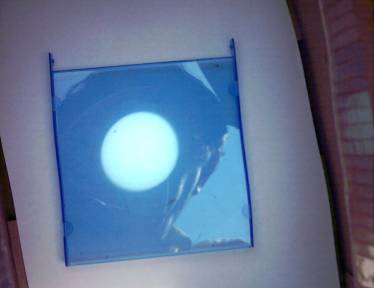| 2nd April 2006 |
UNINTENDED CONSEQUENCES (1) |
Brian Grainger |
|
It all started with the Total Solar Eclipse of 29th March 2006. Well, perhaps it started a little earlier than that, but it makes for a good hook for readers! What has this got to do with computing you ask? The unintended consequences, that started with the total eclipse, led me to question what the purpose was of desktop.ini files. These pop up all over the hard drive, if you set Windows Explorer to show hidden files. The sudden appearance of one on my Windows XP desktop started an investigation that gave part of the answer and also identified a basic Windows XP bug that users should be aware of. I thought I would share my experience. Back to the total eclipse. As part of my daily read of selected web news pages I read Night Sky every Friday at www.space.com. On Friday 24th March there was a piece on the upcoming eclipse. The path of totality included Libya, Turkey and parts of the old USSR. It was a partial eclipse here in the UK and it took place around 9.45-11.20 GMT. This meant I would be at work. I had to consider how I might possibly view the eclipse at work. Obviously, viewing the partial eclipse would depend on the unreliable weather here in the UK. Viewing the total eclipse was a different matter. A search of the web for some webcasts was in order. NASA had set up a web site specially and, in conjunction with 'Exploratium', they were providing a webcast of the eclipse. I have a great deal of trouble viewing NASA webcasts now, but I have viewed Exploratium stuff before. I checked out their web site and they were also showing it via a simple Windows Media or Real Player stream. The next problem was that, since being upgraded to Windows XP at work, every time I start up Media Player I get a message which appears as if it wants to install some Media Player 10 components. Now we are not supposed to install software at work so, being a good boy, I have not ventured further, despite the fact that Media Player is supposed to be allowed. Missing out on a total solar eclipse was a different matter though. I had to get something arranged within 3 working days. A call to the help desk was called for. I asked about getting Media Player to work. Remotely connecting up to my PC the help desk operative simply clicked OK to the screen suggesting the installation. It didn't seem to do much. It certainly did not go off to the web as I thought it would. Anyway, Media Player worked and I thought nothing more of it ... ... Until the next day. When I logged in I suddenly noticed some new icons on my Desktop, one for Media Player and one called desktop.ini. Now the former is irritating, it did not ask if I wanted a desktop icon, but the latter is plain stupid, because you cannot do anything with it. Clicking on it opened Notepad and a reference to 'unregmp2.exe' was amongst the text. I wanted to get rid of the icon but was not sure if it was important or not. Some googling was required. I looked around for things about desktop.ini and, on another search, for things about unregmp2.exe. Microsoft had a very useful page about desktop.ini on their Developers Network. According to that page, desktop.ini had a number of functions including:
I never display pages in web view, so was not really interested in that. I had often seen folder tips and special icons on the folders and wondered how it was done. Now I knew. However, there was no mention of referring to .exe files. Microsoft were holding back on all the uses of desktop.ini, on this web page at least, and I am still none the wiser as to the purpose of the one that suddenly appeared on my desktop. There is another interesting feature of desktop.ini. Sometimes it contains a section: [DeleteOnCopy] Sure enough, if you copy that desktop.ini to another location that section will not appear in the copy. I know this is something to do with rolling out standard desktops to multiple users. For instance, 'My Documents' has in its desktop.ini: [DeleteOnCopy] where <username> is replaced by my logon id. If, as an administrator, I wanted to copy a standard desktop to all the PCs on the network I would not want the My Documents on all the PCs owned by one user. It's a neat trick though - being able to define that certain lines of a file are not copied! I keep a complete backup of my data files on the network on my hard drive. (Our IT have been known to lose a months worth of data from a backup. Once caught, twice shy!). When Media Player was fully installed it caused My Music and My Videos folders to appear amongst my data files. (That will teach me to change the settings the administrators had set up to ones making it easier for me to work - which I had done sometime earlier, so perhaps this story did not start with the eclipse!). These each had a pretty icon, which was that referred to in the appropriate desktop.ini. However, when I copied these files to my hard drive and restored the [DeleteOnCopy] section that referred to the icons, the pretty icons still did not display against the copied folders. I wonder why? Something else must be involved. That pretty much exhausts my findings about desktop.ini to date. If anyone knows more, or can point me to further information on the web, please let me know. Now to the strange unregmp2.exe. This brought up lots of hits on a Google search. They mainly fell into three categories:
As for the appearance of desktop.ini on the desktop, caused by the installation of Media Player 10, the consensus seems to be that it is safe to remove. Nobody seems to report that its removal has caused a problem, which is a good sign. Pity Microsoft could not say something - like why it was formed in the first place! The virus reports seem to be coming from good sources. One can only assume that a virus exists that creates a file that has the name of a normal, not very well-known, Windows file. This is not the first time this has happened. As for the error message that occurs, this is the bug I talked of at the beginning. Imagine being in a situation when you have to repair Windows XP by a re-install, only to come up with this error during the repair process. Much anxiety would be caused to people such as myself. Microsoft know of the problem. You can get full details of it, and how to solve it, by looking at Microsoft Knowledge Base article 889288 (put KB889288 into Google and you will find it). Pity it hasn't been patched out. 

So, what of the total solar eclipse? I watched the webcast from Turkey and I have to say it was quite a good one. The Diamond Ring was wonderful and during the period of totality the corona was quite wide with a number of prominences seen. Here in the UK, the clouds parted where I was. Having taken into work my patent binoculars sun shield, (see the above pictures - that show first the technology involved and then the result when used to project the Transit of Venus a little while ago), I managed to project an image to see the eclipse. No pictures unfortunately. The sun was only 16% obscured at maximum, so it was not one of the best. These things do not happen too often, so I like to catch them if I can. We have a fairly arid period for total solar eclipses now, the next one not occurring till 2008. |
|
|
|
|
|
|
|
|
|